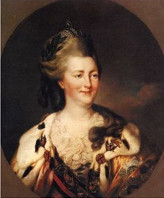
Catherine the Great’s accession to the throne: “I liked the Russian crown more, rather than lady of fiancé”
July 9, the 253rd anniversary from the date of accession to the throne of Catherine the Great the Presidential Library presents little-known materials of the biography and the activity of the Russian empress. They are included, in particular, in the collection "The Romanov dynasty. The 400th anniversary of the Provincial Council in 1613". The artist V. P. Vereschagin created one of the best graphic portraits of the Empress in the digitized by the Presidential Library "Anniversary album in memory of the 300th anniversary of the Romanov House".
The electronic copy of the book P. N. Dirin "Grand Duchess Catherine the Great" of 1884 presents the early life of the future empress - childhood, adolescence, the years of living in Russia as Grand Duchess up to the ascension to the throne. As you know, the future empress, born Sophia Augusta Frederica, Princess of one of the tiny land of Prussia, was brought to St. Petersburg for the continuation of the Romanov family and was married the heir to the throne, Grand Duke Peter Feodorovich on August 21, 1745.
July 9, 1762 as a result of a palace conspiracy, she was proclaimed Empress before the army, high officials and the people.
"On the day of her coronation to Russian realm the Empress cared less about the celebration of this solemn day, and more about trying to meet asylum as possible, who came to her with their needs, and she accepted the requests, - says the historical essay "The Empress Catherine II the Great" of 1873. - On the fifth day Catherine came in person to the Senate and learned that located then in Prussia land army has not received a salary for eight months; in the State's office registered the highest decrees were outstanding; on the occasion of the then war bread in St. Petersburg was sold twice as much against the ordinary price".
The power, which young inexperienced regent inherited, did not have the best days.
"Empress was reported that trade in certain goods is often in the hands of a few dealers who, by agreement among themselves, raised process on their product. One wealthy middleman bought all the cattle that were driven to Moscow and sold it so expensive that a pound of meat has increased threefold in the price. Hearing this, the Empress through the Chief of the Moscow announced that middleman, that "if he does not stop, she would send him to Siberia to buy bulls".
Catherine began decisively eradicating vices that impede the normal development of the state. As described in the above-mentioned book: "In order to destroy the grounds for bribery, at the behest of the Empress in 1763 were set new salaries of the new elevated content, and at the same time rigorously pursuing bribery".
During the reign of Catherine II, the treasury has increased four-fold, significantly increased the population of Russia, it was built hundreds of new cities, rapidly developed industry and agriculture - Russia first started to export grain. For the first time in the Russian state there were introduced paper money.
During the reign of Catherine II were created the Hermitage and the Public Library, the Smolny Institute and the teacher training schools in Moscow and St. Petersburg. It was also founded the Russian Academy. Her era was the time of gaining international significance of the Russian Empire.
Diderot, who had the opportunity to observe Empress the real situation, wrote of her "incomprehensible hardness of thought". The best biographer of Catherine II the pre-revolutionary historian A. G. Brickner noted that she was "as if created for the throne: in history we do not find another woman so capable of managing the affairs". Catherine publicly declared: "This century Russia suffered no losses from any war, and will not allow managing itself".

